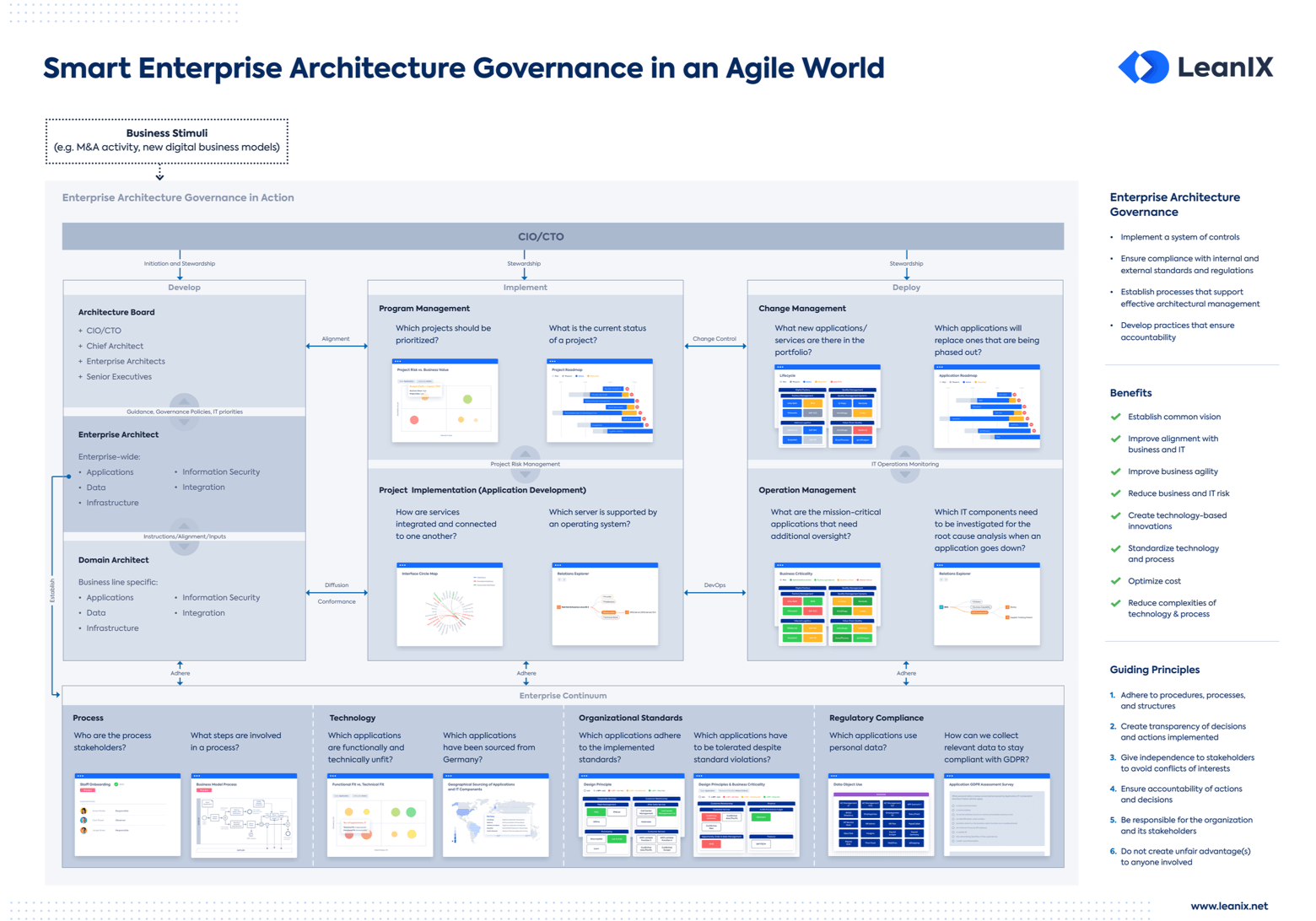EA metrics
Enterprise architecture metrics estimate the progress of EA during the early stages of EA implementation. It also helps measure the efficiency and effectiveness of EA to ensure true value is delivered to the business.
Measuring EA metrics is necessary to:
- Determine how effectively and efficiently the process or service satisfies the customer
- Identify improvement opportunities
- Make decisions based on facts and data
Measurement should:
- Translate organization expectations into goals
- Evaluate the quality of processes
- Track improvements
- Support enterprise strategies
For the EA program to be successful, it needs to be periodically monitored and measured with respect to a set of defined metrics. The status of metrics across an organization can be captured, presented, and communicated effectively using EA scorecards or dashboards.
EA tools
Enterprise architecture tools capture, store, structure, and analyze information pertaining to enterprise architecture, therefore, it is essential to pick the right tool to fit your organization.
EA tools provide support for strategic decision-making by capturing vital enterprise contexts, along with content development and analysis capabilities across the business, information, technology, and solution architectures.
It helps stakeholders analyze and optimize the portfolio of business strategies, organizational structures, business processes/tasks and activities, information flows, applications, and technology infrastructure.
An EA tool covers the following functional features:
- Modeling capabilities
- Framework and standards support
- Ability to create or import models and artifacts
- Robust and flexible repository and meta-model
- Ease of usability
- Integration to multiple enterprise usage tools
- Ability to impact at all levels of the enterprise domains
- Administrative capabilities to meet diverse needs such as security, audit control, collaboration, configuration, and versioning
📚 2023 Gartner® Magic Quadrant™ for Enterprise Architecture Tools
Conclusion
A well-designed enterprise architecture governance structure can be essential in reducing IT costs and risks while accelerating decision-making and delivery. EA governance ensures that an EA program is managed properly to produce artifacts and plans truly representative of organizational goals and needs. As well, EA governance ensures investment decisions become aligned with the EA from initiation to implementation.
Governance is an important aspect of any change initiative. EA is no exception. Governance provides a platform for various stakeholders to interact regularly and maintain enterprise architecture.
An EA program definition should not span for years. It should deliver business value in a short amount of time. The program output should be actionable, and it should always have its impact measured—not its activity.
In modern EA, the Ivory Tower approach of EA governance does not work. This approach causes EA programs to fail, especially when the EA program does not consider the demands of digital business, driven by a shift in value creation to ecosystems, platforms, and outward-facing architecture. The role of EA governance in modern EA is summarized below:
- Does not focus on current state architecture
- Continues to advance EA programs to the next level of maturity
- Understands organization's business strategy, business models, and goals, and determines how EA can help deliver business value
- Does not get distracted by EA frameworks, industry reference models, governance, and EA tools
- Shifts emphasis from top-down governance to an EA “Center of Excellence”
- Adopts a continuous innovation approach to EA programs, refines each cycle
- Does not employ EA tools without an understanding of their use cases and capabilities
Editor´s Note
This content was contributed by Dr. Gopala Krishna Behara, senior enterprise architect in the GEA Practice division of Wipro. He has over 22 years of IT experience and can be reached at gopalkrishna.behra@wipro.com. The author would like to thank Hari Kishan Burle and Raju Alluri, Wipro Technologies’ GEA Practice for providing support and their knowledge in the writing of this article.
Disclaimer
The views expressed in this article/presentation are that of authors and Wipro does not subscribe to the substance, veracity, or truthfulness of the said opinion.

/EA-Governance_Poster_Resource_Page_Thumbnail.png?width=450&height=315&name=EA-Governance_Poster_Resource_Page_Thumbnail.png)


![The Enterprise Architect of Tomorrow [White Paper]: Practical insights on how to become data-driven, agile-minded, and forward thinking. »](https://no-cache.hubspot.com/cta/default/2570476/49fd1c31-67ad-464a-9aae-3ed5e866a24e.png)









